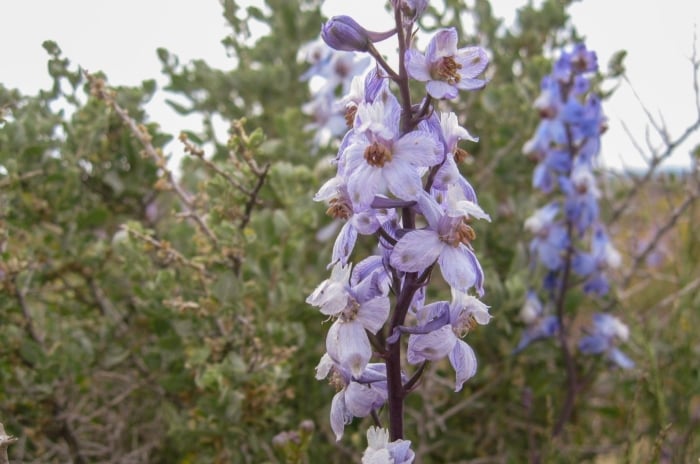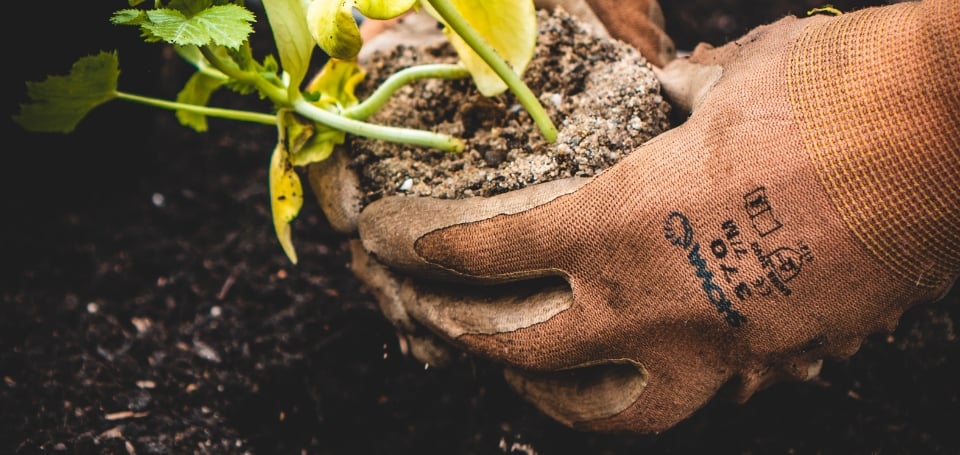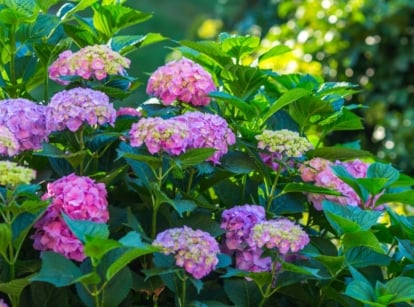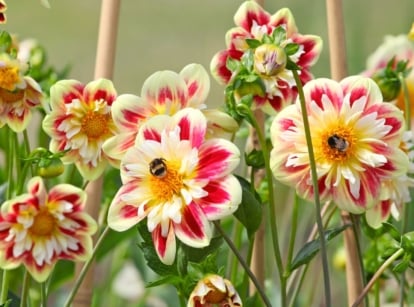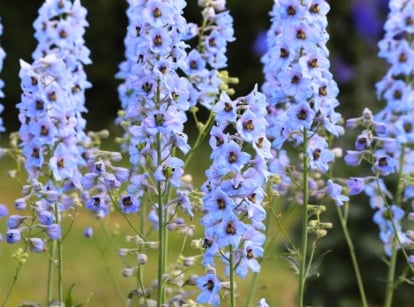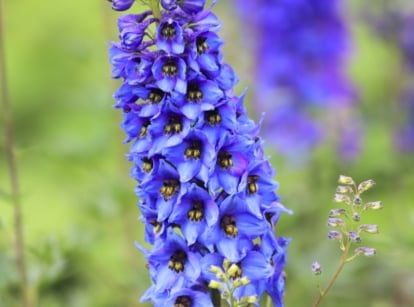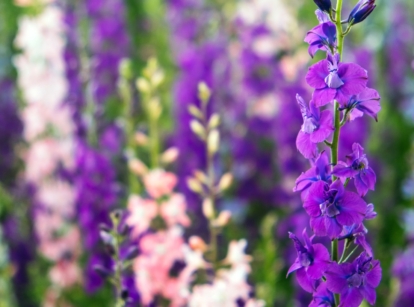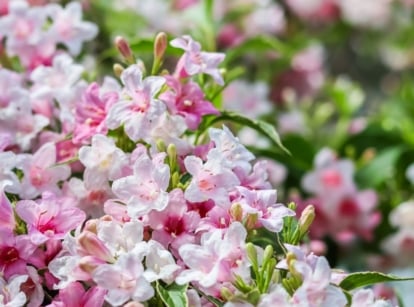5 Delphinium Diseases: Prevention and Treatment
Healthy delphiniums bring floriferous spires of bell blooms that create a spectacle and beckon pollinators. The short-lived perennials are susceptible to common diseases that can counteract the blooms. Gardening expert Katheirne Rowe outlines what to look for, as well as how to prevent delphinium problems for an easier show of color.

Contents
Elegant and stately, Delphinium boasts large, deep blue bell blooms on tall stems, with cultivars in a range of hues and sizes that are glorious in flower. They’re worth growing for the show of spires, even if it’s a bit challenging to meet their optimal growing conditions.
Delphiniums are susceptible to several diseases, particularly fungal and bacterial pathogens that arise from overly damp conditions. To bask in a wave of blooms, we’ll explore how to scout, prevent, and treat common delphinium diseases.
Pacific Giants Blend Delphinium Seeds
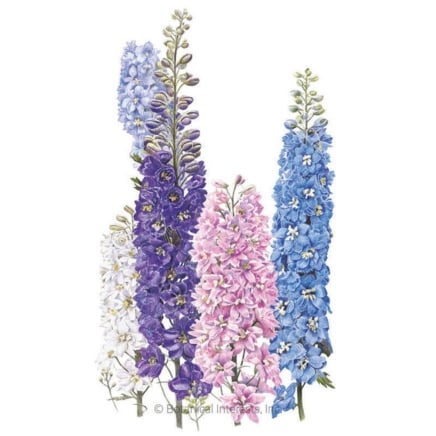
- Tall, Elegant Spires with Large, Vibrant Blooms
- Award-Winning Heirloom Variety
- Attracts Hummingbirds and Pollinators
- Excellent as a Cut Flower and Garden Focal Point
- Mildew-Resistant and Ideal for Background Planting
Setting Delphinium Up for Success

While delphiniums are low maintenance in the right conditions, it can be challenging to get them to perennialize. They often grow as spring annuals before dying back in summer heat, preferring climates with mild summers. Hot, humid southern climates can prove too much amid delphinium diseases.
There are North American native species, like blue larkspur, Delphinium carolinianum, that reseed and spread readily in their optimal conditions. More common in cultivation are those of European and Asian origin, especially D. elatum and related hybrids bred for exceptional flowering and performance.
Optimal growing conditions for delphinium include:
- Full sun to partial shade, with four or more hours of sun (six hours is ideal for disease-prevention)
- Organically rich, well-drained soils
- Evenly moist soils, allowed to dry slightly between watering
- Staking tall varieties and situating them out of windy zones
Root and Crown Rot

Certain conditions are ripe for delphinium diseases that hamper growth. Wet soils are one of the primary situations that do them harm.
Delphiniums do best with even moisture, with soils drying one to two inches deep between watering sessions. With long taproots, they can reach moisture well below the soil surface, allowing them to tolerate short dry spells.
With overwatering, an inundation of rainfall, or poorly draining soils, the roots sit in soggy conditions. Oversaturated, they’re likely to succumb to diseases like root and crown rot.
Root rot and crown rot occur most in warm, humid environments, prolonged wet conditions, and those with poor air circulation. With root rot, the pathogens Erwinia and Phytophthora, among others, impact feeder roots, which become unable to absorb water and nutrients. Signs of root rot include drought-stressed leaves and stems that turn yellow and wilt.
Check for rot by inspecting stems and roots slightly below the soil line. Rotting roots will be yellow or brown rather than a healthy white. With crown rot, brown patches and rotting appear where the leafy stems emerge just above the soil line. Brown or black lesions may also crop up.
Treatment
To treat these delphinium diseases, remove any specimens in severe decline. In early stages, remove any brown areas from the crown. Try lifting the plant to inspect and clip off any decaying root portions.
Delphiniums are sensitive to root disturbance, and disruption may increase stress, but you can try replanting them in higher ground. There’s a chance it may rebound after root rot if caught early.
Prevention
The best way to prevent rot is to avoid overhead watering and limit saturated situations. Water at the base of the perennial, either by hand or with drip irrigation or soaker hoses, especially after flower spikes elongate. Ground watering delivers moisture to the roots without splashing foliage or the crown.
Increase air circulation, especially in humid conditions. At planting, take care not to bury the crown or plant too deeply. Compensate for settling by planting just slightly above the soil level. Use elevated mounds or beds to promote drainage.
Also, check the soil moisture prior to watering. Touch the surface and poke a few inches deep to determine if the soil is dry and crumbly or wet and sticky. If dry, it’s time to water. If on the wet side, reduce the frequency of irrigation. In dry weeks, supplement with deep watering once or twice to achieve even moisture.
Powdery Mildew

One of the most common delphinium diseases, powdery mildew, thrives with a lack of air circulation. The fungus Erysiphe betae pops up as a grayish-white powdery coating on leaves, stems, and buds. Leaves turn yellow, distort, and drop during severe infections.
Spores spread easily by traveling on the wind, gaining garden entry with infected plants, unsanitized tools, and splashing up from the soil via raindrops and irrigation. The spores start on the leaves in spots and patches and spread to the stems, depleting the perennials of nutrition. Fortunately, this deplphinium disease is treatable with early detection.
Treatment
Handpick and remove the infected leaves when possible. Discard them in a garbage bag or burn them to keep them away from the garden and compost pile.
Horticultural oils like neem can treat the fungal disease early on and prevent spread to healthy tissue. Follow application directions, as these treatments impact beneficial insects that visit the blooms for nectar and pollen.
Prevention
Opt for resistant delphinium varieties and those that tolerate heat and humidity. To prevent powdery mildew, practice good irrigation by avoiding wetting the leaves when possible. This helps keep spores from splashing up from the soil and spreading. If using overhead irrigation, water early in the day so foliage dries in the sun and breeze.
Proper spacing at planting allows plenty of air movement around leaves and stems. Prune away other plants that encroach and may foster damp conditions. If established clumps become crowded, divide them in early spring when new growth emerges. Capture a strong stem and leave plenty of roots intact on each divided portion.
Division rejuvenates the colony with proper spacing, access to nutrients and sunlight, and room to continue growing.
Botrytis

Botrytis cinerea, or gray mold, is a delphinium disease that presents as light grayish-brown watery spots on petals and leaves. They discolor, and a “fluffy” mold appears. Stems may also develop tan-brown cankers that cause them to collapse.
Like powdery mildew, botrytis thrives in high humidity, especially in cool and damp conditions of spring and fall, and intensifies with limited air circulation.
Treatment
Neem oil treats botrytis early on, as does potassium bicarbonate. A powdered formula mixed with water is useful as a regular spray treatment. Add mycorrhizae and beneficial bacteria to the soil as a countermeasure. Look for Trichoderma and Cladosporium to help ward off botrytis.
Botrytis is an adaptable fungus that adjusts to fungicides. Use both organic foliar applications and added soil microbes to keep the spores from developing resistance.
Prevention
To prevent botrytis, limit prolonged moisture and dampness. Take care not to overwater or overfertilize. Excess nitrogen causes weak growth and increases susceptibility. Proper spacing and avoiding wetting the leaves when feasible are effective defenses.
Deadhead spent blooms to keep them from fostering the spores when they drop and lay in place. Remove fallen debris to minimize an optimal environment for fungus.
Bacterial Leaf Spot

Bacterial leaf spot is a common delphinium disease that grows on leaf surfaces. Brown or black spots with tan centers become more significant and spread across leaves and stems over time. As the pathogens spread, affected leaves and stems blacken.
The likelihood of leaf spot increases in wet conditions, with spots appearing when leaves stay wet from prolonged moisture from rain or overhead watering.
Treatment
Cut off diseased leaves and remove any that drop to avoid overwintering for the next season. Discard the impacted parts away from the garden to prevent the spread.
Sterile tools help reduce the spread of bacteria and fungi when moving between plants. Sanitize pruners with an alcohol wipe, a dip, or spray with a 70% isopropyl alcohol solution while working.
Prevention
Ample air circulation through proper spacing is the best preventative for leaf spot. Also, ground-level watering rather than spraying the leaves reduces damp conditions. Add a mulch layer to reduce soil splash during watering. Mulch also offers additional benefits like temperature regulation, weed suppression, and moisture retention.
If you have a problem with leaf spot, grow the perennial in a different location the following season. Crop rotation can help reduce overwintering spores.
Aster Yellows

Aster yellows is a delphinium disease that spreads via leafhoppers. The sap-sucking pests spread the phytoplasma (similar to a bacterium) as they feed on plant parts and travel between specimens.
The phytoplasma causes weak, distorted leaves and shoots, overall yellowing, and malformed, greenish flowers where tissues form instead of blooms.
Treatment
Unfortunately, this delphinium disease doesn’t have a working treatment in the home garden. Spot the signs early and remove infected delphiniums to minimize the impact on surrounding plants.
Prevention
Treat severe leafhopper infestations to avoid the introduction of the phytoplasma. Remove fallen leaves and debris to prevent the spread, and disinfect tools. Provide the best cultural practices of consistent watering, appropriate spacing, and nutrient-rich soils with good drainage to boost vigor and resistance to insect and disease damage. Keep beds and nearby areas weed-free to prevent hosting the virus over the winter.

